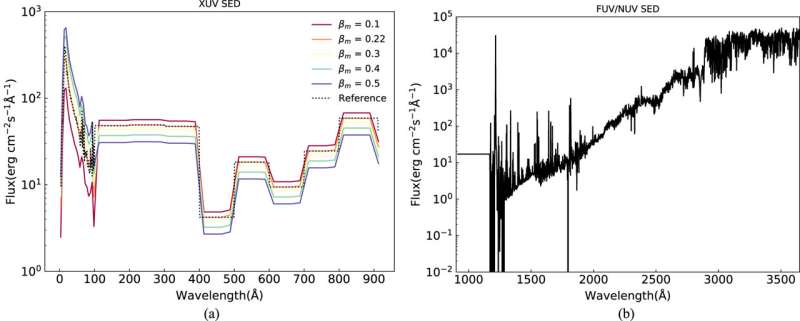Escaping atmosphere of hydrogen and helium from exoplanet studied with advanced simulations

Researchers from the Yunnan Observatories of the Chinese Academy of Sciences and their collaborators reproduced the observed transmission spectra of the exoplanet WASP-52b at different wavelength bands and studied the properties of its hydrogen and helium atmosphere.
The results were published in The Astrophysical Journal on Sept. 13.
Close-in exoplanets receive intense high-energy radiation from their host stars, such as X-rays and extreme ultraviolet (XUV) radiation. In gas-rich exoplanets, the atmosphere may absorb this high-energy radiation, thus heating the atmosphere and causing it to expand to overcome the planet's gravitational potential and escape into the interstellar medium.
This phenomenon is known as planetary atmosphere escape, which can cause the loss of a large amount of material from the planet and has important effects on the composition, evolution and even the overall distribution of the planet.
The composition and properties of the planetary atmosphere can be studied by analyzing the absorption of spectral lines at different wavelength bands, for example, the optical band (Hα) and near-infrared band (He λ10830Å) lines, the so called transmission spectra.
In this study, the researchers used the hydrodynamic atmospheric escape model and the radiation transfer model to simulate the transmission spectra of WASP-52b. They introduced the Monte Carlo model to simulate the Lyα resonant scattering inside the exoplanetary atmosphere for the first time, by assuming that both the stellar Lyα radiation and the planetary atmosphere are in spherical.
Based on the distribution of the Lyα scattering rate Pα, the researchers calculated the Hα absorption, which is caused by the hydrogen atoms in the first excited states. They also calculated the distribution of metastable helium atoms in detail and simulated the transmission spectra of hot Jupiter WASP-52b in the optical band (Hα) and near-infrared band (He λ10830Å).
They constrained the level of X-rays and extreme ultraviolet radiation received by the planet, as well as the hydrogen to helium abundance ratio in the planetary atmosphere, and revealed that hydrogen and helium originated from the escaping atmosphere. The findings can help to constrain the physical parameters of the atmosphere and to better understand its composition and structure.
More information: Dongdong Yan et al, Modeling the Hα and He 10830 Transmission Spectrum of WASP-52b, The Astrophysical Journal (2022). DOI: 10.3847/1538-4357/ac8793
Journal information: Astrophysical Journal
Provided by Chinese Academy of Sciences




















